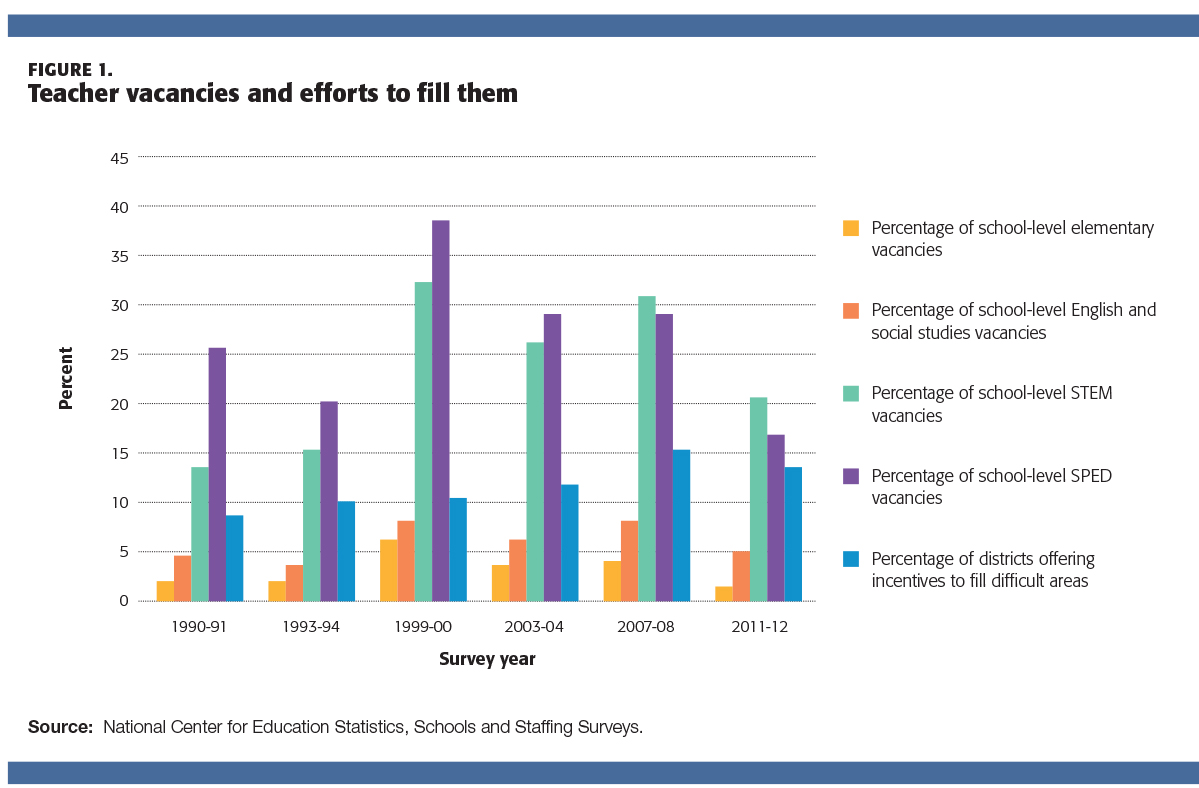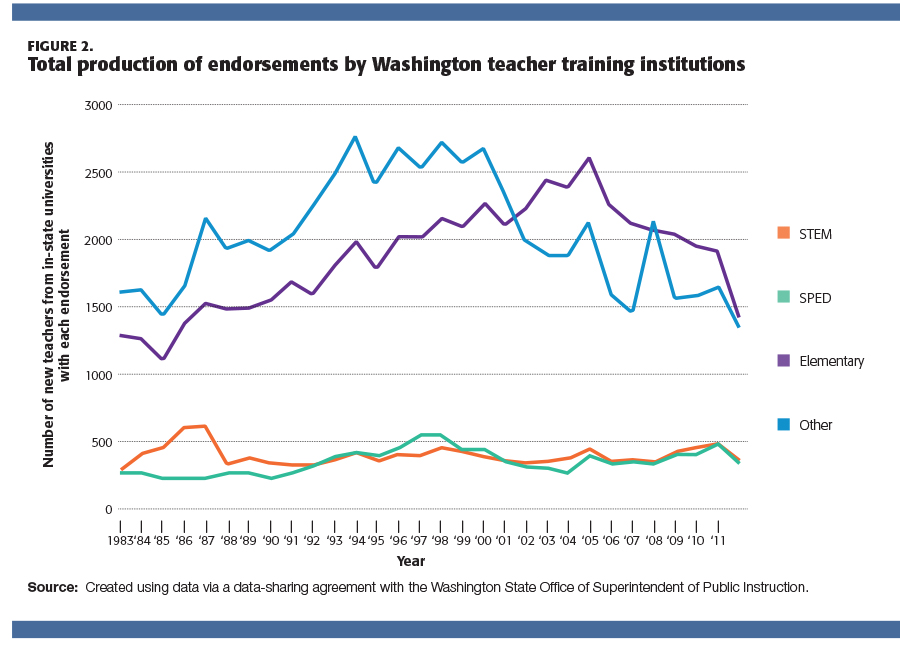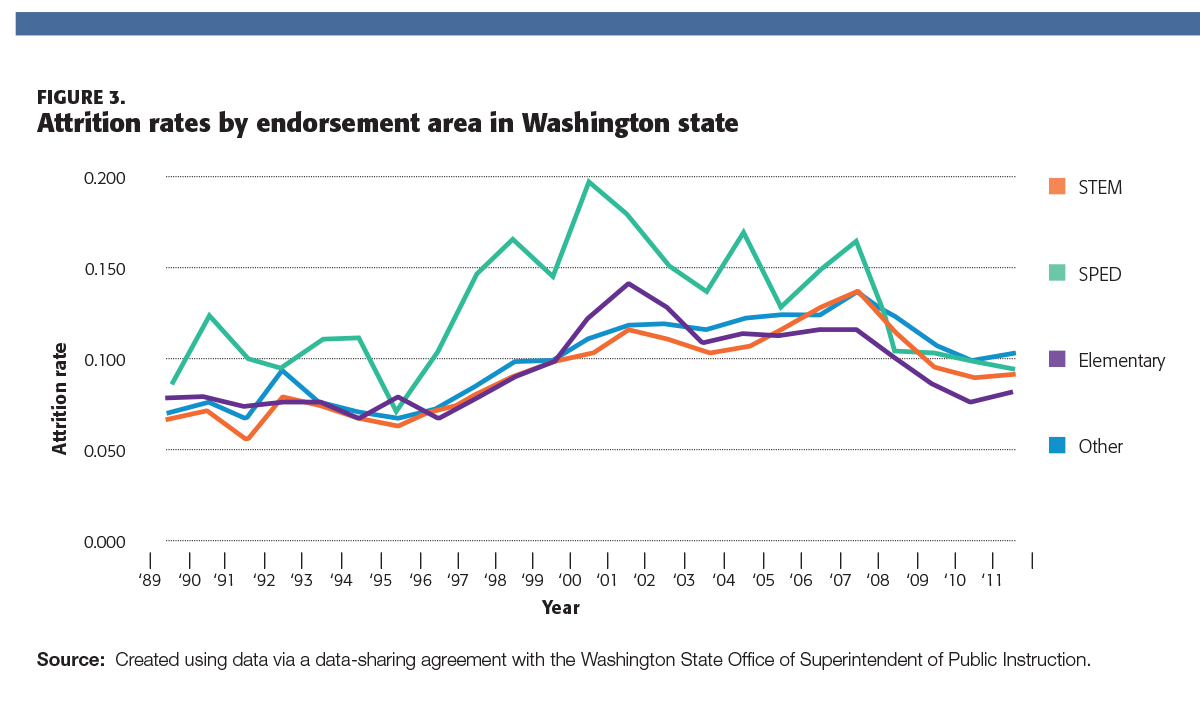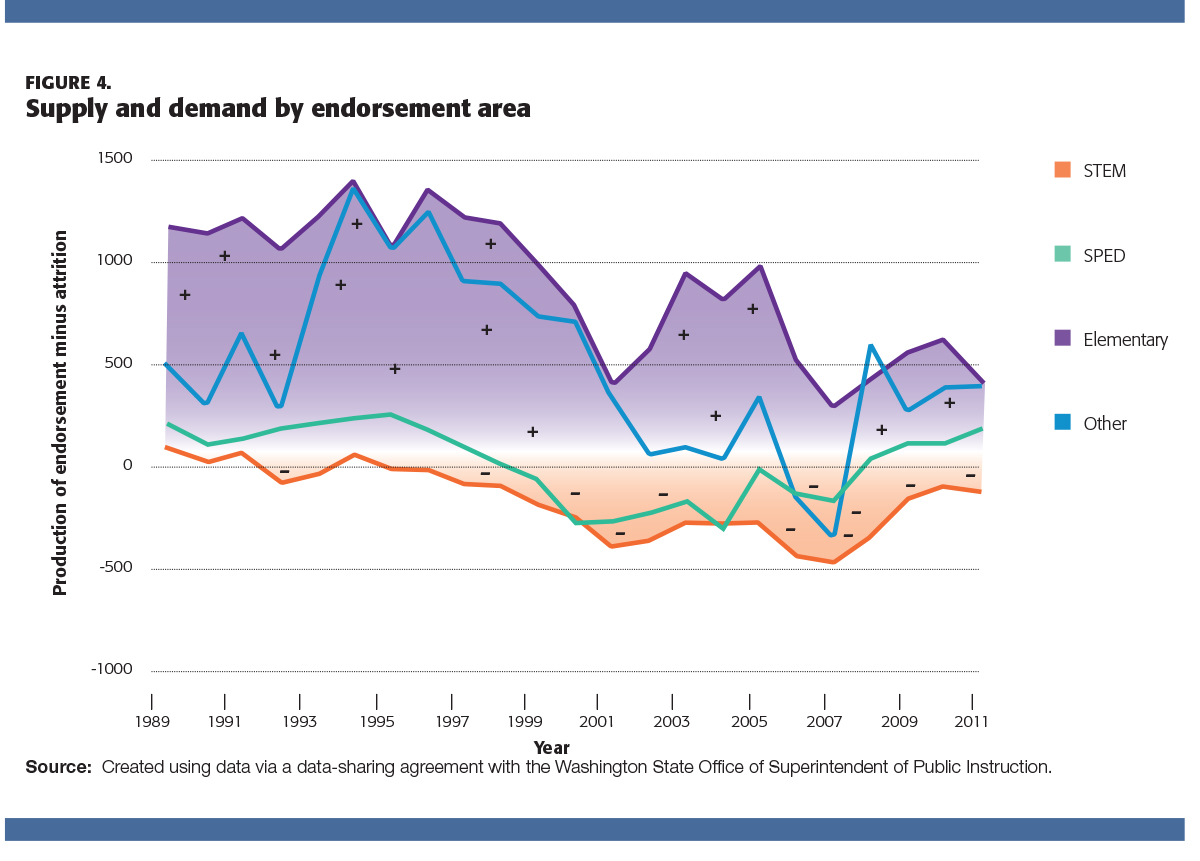
Colleges and policy makers have access to solutions that could reduce the shortage of STEM and special education teachers.
Policy makers and politicians across the country have increasingly prioritized improving the quality of the teacher workforce. Of particular and growing concern is the shortage of qualified teachers in science, technology, engineering, and mathematics (STEM) subjects. This is fueled in part by the belief that STEM education is crucial to assuring that the U.S. remains a global technology and economic leader and in part by weak U.S. student performance in mathematics and science on international comparisons.
Despite this knowledge and the consistent rhetoric about enhancing STEM supply, school systems continue to face difficulties staffing certain classrooms with qualified teachers. This is also true for special education (SPED). Over half of all districts and over 90% of high-minority districts report difficulties recruiting and retaining teachers designated as highly qualified in STEM and SPED under No Child Left Behind. School administrators across the country consistently report greater difficulty filling SPED and STEM teaching appointments compared to alternative endorsement areas (see Figure 1).

In Washington state, the setting for our discussion, the trends in teacher shortages largely mirror those observed nationally. In nearly every year since 1990, Washington has been listed as having shortages in STEM or SPED fields (U.S. Department of Education, 2015). There is new evidence that prospective teachers in Washington state endorsed to teach either in STEM or SPED find employment in public schools far more quickly than teaching candidates endorsed in other areas (Goldhaber, Krieg, & Theobald, 2013). For example, our models predict that an average prospective teacher endorsed in STEM or SPED has a 75% chance of being employed in a teaching job within three years of graduation, while the average teacher endorsed in elementary education has just a 50% chance of finding a teaching job in the same timeframe.
As it turns out, the employment advantages of STEM and SPED teachers are not short-term: Employment prospects for STEM and SPED teachers are consistently better going back to 1996, when Washington began gathering these data. However, there is little evidence that the in-state production of teachers across different training areas has adjusted to the relative needs in those areas. For instance, over the past 20 years, the production of STEM and SPED teachers by Washington state teacher training programs has remained largely static. In fact, despite all the rhetoric about the importance of STEM education, the production of STEM teachers was for many years in the 1980s substantially higher than it is today (see Figure 2).

Special education staffing issues are compounded because SPED teachers are more likely to leave the K-12 workforce than teachers in other areas. Figure 3 shows attrition rates (the percent of teachers who leave the state teaching workforce each year) by endorsement area over time. For most of the past 25 years, SPED teachers are more likely to leave the workforce in Washington state than teachers in other areas. That said, attrition rates have converged recently, a time period when the state experienced significant budget shortfalls and teachers found both retirement and outside job prospects less attractive.

We also can investigate supply and demand by endorsement area by subtracting the number of teachers who leave the workforce from the number of newly endorsed recipients within each endorsement area in a given year. A value of zero means that teacher production equals teacher attrition in that endorsement area. These estimates indicate that for a period of more than five years for SPED and more than 10 years for STEM, in-state production of endorsements has not kept up with the number of teachers exiting those fields (see Figure 4). Meanwhile, over this same period, in-state production of endorsements other than SPED and STEM have far exceeded the number of teachers exiting with these endorsements. For example, from 1995 to 2010, the number of exiting elementary endorsements totaled 21,796, while 34,571 were produced, meaning that the state produced 12,775 more elementary teachers than left the profession. By contrast, during this same period, 10,184 STEM teachers exited the profession, while only 6,465 new STEM teachers were produced by in-state teacher training programs, leading to an estimated net shortage of 3,719 STEM teachers.

When these results are coupled with the fact that K-12 school enrollments grew by more than 7% over the same period and student course taking in math and science also increased (National Science Board, 2012), the supply of STEM and SPED teachers is simply not keeping up with demand.
This raises the question: Why don’t we see better alignment between supply and demand for STEM and SPED teachers, and what can school districts, the state and federal government, and teacher training institutions do about this misalignment?
School districts
One potential culprit for the misalignment of supply and demand in the teacher workforce is the widespread use by school districts of single salary schedules, in which teachers of the same experience and education level receive the same salary regardless of position and specialty area. This means that a STEM or SPED teacher is paid the same as an elementary teacher with the same experience and degree level, even though the STEM teacher likely has significantly better job prospects outside the teaching field (Walsh, 2014), and the SPED teacher likely faces more difficult working conditions (Fore et al., 2002). Therefore, one of the most straightforward solutions available to district policy makers is to move beyond single salary schedules and offer differential economic incentives to teachers in high-need areas.
Almost 90% of U.S. public school teachers teach in districts that use a single salary schedule.
Differential pay could have a twofold effect on local teacher labor markets. In the short term, higher compensation could retain more teachers in high-need fields. For example, a modest bonus of $1,800 to certified math, science, and special education teachers in North Carolina school districts was sufficient to reduce mean turnover rates of the targeted teachers by 17% (Clotfelter et al., 2008). But in the long term, it also could increase the pool of prospective teaching candidates in these areas. This approach, however, has previously been judged to be somewhat untenable for districts because collective bargaining agreements can stifle implementation (Guthrie & Zusman, 1982); in fact, almost 90% of U.S. public school teachers work in districts that use a single salary schedule. Even when administrators have flexibility to implement differentiated pay strategies, they are not terribly adept at effectively aligning compensation policies with particular staffing needs (Grissom & Strunk, 2012; Strunk & Zeehandelaar, 2013).
Washington state provides an extreme example because it is one of 10 states across the country with a statewide salary allocation schedule. Despite this, the system still allows some flexibility for districts to provide differential pay for teachers in high-need areas. But when we reviewed teacher collective bargaining agreements in every district in Washington state subject to collective bargaining (270 total districts), we could identify only two districts with additional financial incentives for STEM or SPED teachers. Tacoma School District offers a bonus to newly hired certificated teachers and an additional bonus to teachers who sign contracts for teaching assignments in the district’s hard-to-fill positions. Bethel School District provides teachers in self-contained special education classrooms a $500 stipend. It remains puzzling why more districts do not offer financial incentives, considering that the strategy is hardly novel and that relative shortages in specific fields are not, as we indicated above, a new phenomenon (National Commission on Excellence in Education, 1983; Rumberger, 1987). Some districts offer noneconomic incentives to STEM and SPED teachers (e.g., extra prep time or extra leave days), which fits with empirical evidence that districts and administrators often must rely on nonmonetary compensation to retain high-quality teachers (Player, 2010).
State and federal levels
In addition to district-level policy solutions, state and federal policy makers also have access to a number of intervention strategies. Some states have explored statewide incentive programs, which offer money and loan forgiveness to prospective teachers in key areas. For example, Georgia recently implemented a salary-bonus program for certified teachers in math and science, which allows starting teachers in these subjects to advance several steps on the state’s salary schedule.
An average prospective teacher endorsed in STEM or SPED has a 75% chance of being employed in a teaching job within three years of graduation, while the average teacher endorsed in elementary education has just a 50% chance of finding a teaching job in the same timeframe.
Darling-Hammond and Sykes (2003) suggest additional state and federal strategies for increasing the supply of teachers in high-need areas. Rather than devising individual qualification and certification requirements, Darling-Hammond and Sykes recommend that states collaborate to create regional, if not national, credentialing guidelines to mitigate interstate barriers to teacher mobility. As it is now, many states mandate additional or redundant requirements for teachers transferring from other states. As former superintendent Shawn Arevalo McCollough (2014) notes, “It’s often said that Bill Gates would not be considered qualified to teach students about computer science in many states; yet who better could lend experience and knowledge to our students?” (p. 1). At the federal level, a number of incentive programs focus on improving teacher recruitment and retention. Darling-Hammond and Sykes recommend consolidating all of the current small-scale fellowships, scholarships, and loan forgiveness programs into a sustained program directed at the nation’s most pertinent teaching needs, with substantial funding set aside to target teacher shortage areas.
Teacher training institutions
Finally, colleges should play an important role in addressing the shortage of STEM and SPED teachers. For example, colleges could improve their communication to students of the employment prospects of different specialty areas and the myriad federal subsidy and incentive programs available to teachers. Colleges also could consider reducing the cost and difficulty for individuals to obtain certification in STEM, SPED, or other high-need fields. For instance, the University of California system offers the California Teach program, which provides all STEM students the opportunity to complete the STEM major and pedagogical training in a four-year program (National Academy of Sciences, 2007). The California Teach program streamlines the certification process and offers students who complete the program a $5,000 scholarship.
Action is required to meet the growing demand for STEM and SPED teachers in Washington state, but a number of potential solutions exist to address the problem.
Given the considerable attention to shortages of STEM and SPED teachers, it seems odd that, collectively, colleges in Washington have not adjusted to increase STEM and SPED certified graduates. The unresponsiveness by Washington colleges might be the result of the position/status of teacher preparation programs within universities and an underlying lack of adequate incentives to change practices. For instance, engineering and science degrees are more expensive for higher education institutions to produce (Ehrenberg, 2012) and more difficult and costly for students to undertake (Stinebrickner & Stinebrickner, 2013). The increased difficulty educating students in STEM-related subjects could deter education programs from bolstering enrollment in these areas.
Furthermore, some researchers have suggested that many university education programs face pressure from institutional leadership to maintain budget surpluses to help fund other university programs (Howard, Hitz, & Baker, 1998). Colleges may not have sufficient incentives to increase their production of STEM and SPED teachers, but state and federal agencies could provide such incentives.
Conclusion
Action is required to meet the growing demand for STEM and SPED teachers and while we highlight the issue in the context of Washington state, this problem is playing out in states across the country. We offer a number of potential solutions to address the problem: differential pay for STEM and SPED teachers, reducing barriers to entry for out-of-state teachers, incentivizing colleges to increase the production of STEM and SPED teachers, or a combination of these options. Whatever the solution, the mismatch between the supply and demand of STEM and SPED has been so persistent that it is unlikely to disappear without concerted action by policy makers.
References
Clotfelter, C., Glennie, E., Ladd, H., & Vigdor, J. (2008). Would higher salaries keep teachers in high-poverty schools? Evidence from a policy intervention in North Carolina. Journal of Public Economics, 95 (5), 1352-1370.
Darling-Hammond, L. & Sykes, G. (2003). Wanted: A national teacher supply policy for education: The right way to meet the highly qualified teacher challenge. Education Policy Analysis Archives, 11 (33).
Ehrenberg, R. (2012). American higher education in transition. The Journal of Economic Perspectives, 26 (1), 193-216.
Fore, C., Martin, C., & Bender, W.N. (2002). Teacher burnout in special education: The causes and recommended solutions. The High School Journal, 86 (1), 36-44.
Goldhaber, D., Krieg, J., & Theobald, R. (2013). Knocking on the door to the teaching profession? Modeling the entry of prospective teachers into the workforce. Working Paper No. 2013-2. Seattle, WA: University of Washington Bothell, Center for Education Data and Research.
Grissom, J. & Strunk, K. (2012). How should school districts shape teacher salary schedules? Linking school performance to pay structure in traditional compensation schemes. Educational Policy, 26 (5), 663-695.
Guthrie, J. & Zusman, A. (1982). Teacher supply and demand in mathematics and science. Phi Delta Kappan, 64 (1), 23-33.
Howard, R., Hitz, R., & Baker, L. (1998). A national study comparing the expenditures of teacher education programs by Carnegie classification and with other disciplines. Action in Teacher Education, 20 (3), 1-14.
McCollough, S. (2014). Most states adopt Common Core standards, yet many face STEM teacher shortage. Washington, DC: American Board. http://bit.ly/1LMhScu
National Commission on Excellence in Education. (1983). A nation at risk: The imperative for educational reform. Washington DC: Author.
National Academy of Sciences. (2007). Rising above the gathering storm: Energizing and employing America for a brighter economic future. Washington, DC: National Academies Press.
National Science Board. (2012). National science and engineering indicators 2012. Arlington, VA: National Science Foundation.
Player, D. (2010). Nonmonetary compensation in the teacher labor market. Education Finance and Policy, 5 (1), 82-103.
Rumberger, R. (1987). The impact of salary differentials on teacher shortages and turnover: The case of mathematics and science teachers. Economics of Education Review, 6 (4), 389-399.
Stinebrickner, T. & Stinebrickner R. (2013). A major in science? Initial beliefs and final outcomes for college major and dropout. (Working paper 19165). Cambridge, MA: National Bureau of Economic Research.
Strunk, K., & Zeehandelaar, D. (2013). Added bonus? The relationship between California school districts’ specialized teacher staffing needs and the use of economic incentive policies. Educational Policy, 29 (2), 283-315.
U.S. Department of Education. (2015). Teacher shortage areas nationwide listing. Washington, DC: Office of Postsecondary Education.
Walsh, P. (2014). When unified teacher pay scales meet differential alternative returns. Education Finance and Policy, 9 (3), 304-333.
Citation: Goldhaber, D., Krieg, J., Theobald, R., & Brown, N. (2015). Refueling the STEM and special education teacher pipelines. Phi Delta Kappan, 97 (4), 56-62.

ABOUT THE AUTHORS

Dan Goldhaber
DAN GOLDHABER is director of the Center for Education Data and Research at the University of Washington and the director of the National Center for Analysis of Longitudinal Data in Education Research at the American Institutes for Research , Seattle, WA.

John Krieg
JOHN KRIEG is a professor in the College of Business and Economics at Western Washington University, Bellingham, Wash.

Nate Brown
NATE BROWN is a researcher at the Center for Education Data & Research, University of Washington Bothell, Seattle, Wash.

Roddy Theobald
RODDY THEOBALD is a senior researcher at the National Center for Analysis of Longitudinal Data in Education Research and vice president of the American Institutes of Research .










